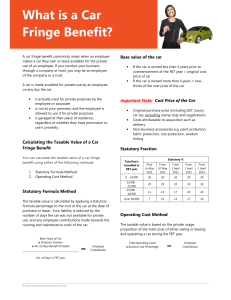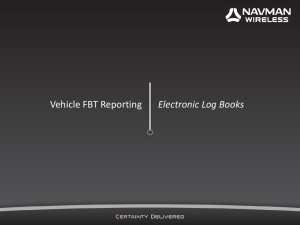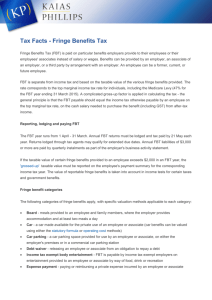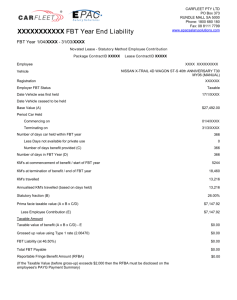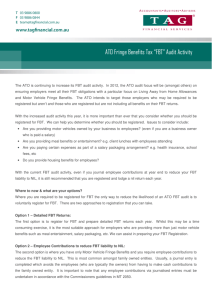Special Report - New multi-rate fringe benefit tax (FBT)
advertisement
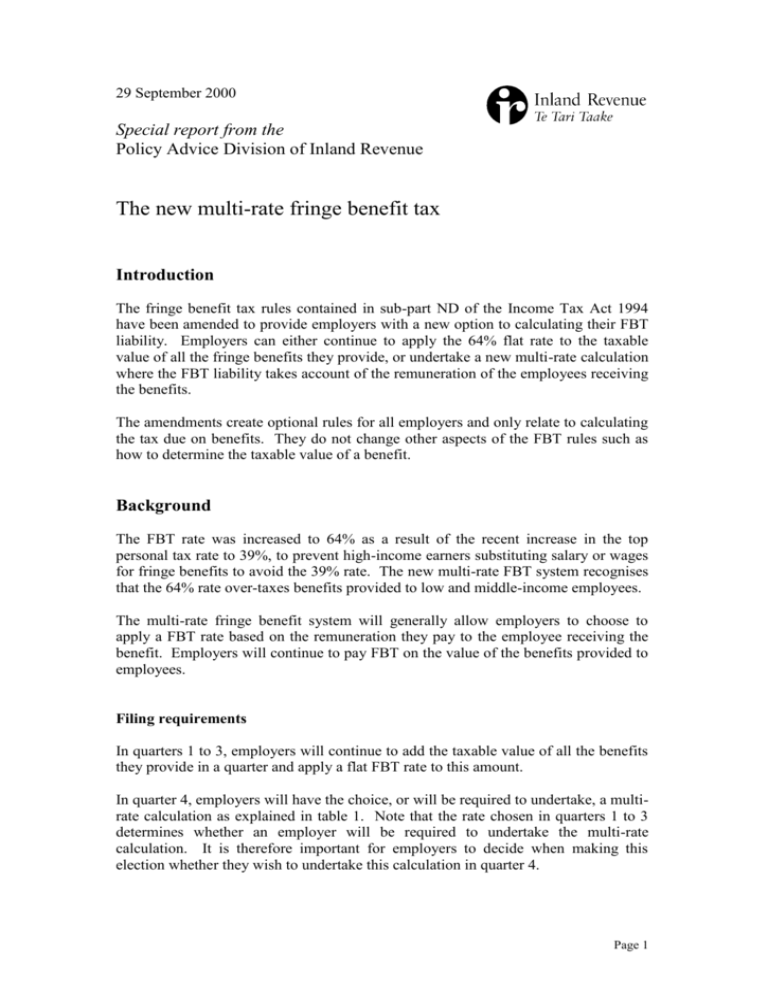
29 September 2000 Special report from the Policy Advice Division of Inland Revenue The new multi-rate fringe benefit tax Introduction The fringe benefit tax rules contained in sub-part ND of the Income Tax Act 1994 have been amended to provide employers with a new option to calculating their FBT liability. Employers can either continue to apply the 64% flat rate to the taxable value of all the fringe benefits they provide, or undertake a new multi-rate calculation where the FBT liability takes account of the remuneration of the employees receiving the benefits. The amendments create optional rules for all employers and only relate to calculating the tax due on benefits. They do not change other aspects of the FBT rules such as how to determine the taxable value of a benefit. Background The FBT rate was increased to 64% as a result of the recent increase in the top personal tax rate to 39%, to prevent high-income earners substituting salary or wages for fringe benefits to avoid the 39% rate. The new multi-rate FBT system recognises that the 64% rate over-taxes benefits provided to low and middle-income employees. The multi-rate fringe benefit system will generally allow employers to choose to apply a FBT rate based on the remuneration they pay to the employee receiving the benefit. Employers will continue to pay FBT on the value of the benefits provided to employees. Filing requirements In quarters 1 to 3, employers will continue to add the taxable value of all the benefits they provide in a quarter and apply a flat FBT rate to this amount. In quarter 4, employers will have the choice, or will be required to undertake, a multirate calculation as explained in table 1. Note that the rate chosen in quarters 1 to 3 determines whether an employer will be required to undertake the multi-rate calculation. It is therefore important for employers to decide when making this election whether they wish to undertake this calculation in quarter 4. Page 1 TABLE 1: F ILING R EQUIREMENTS Rate to use – quarters 1 to 3 only apply to quarterly filers Return period Due date - payment and return Quarter 1 49% or 64% 20 July Quarter 2 49% or 64% 20 October Quarter 3 49% or 64% 20 January Quarter 4, annual or income year return If 49% was used in any quarter you must undertake the multirate calculation. Quarterly filers (31 May) Annual filers (31 May) If 64% was used in every quarter you can undertake the multi-rate calculation or simply use the 64% rate. Income year filers (Terminal tax date) Annual and income year filers will continue to file once a year and choose either to use the 64% rate or undertake the multi-rate calculation. It is important for employers who may wish to undertake the calculation to make sure they have adequate records of which employees have used which benefits during the year. Note that the usual due date for the FBT return and payment for quarter 4 return filers has been extended to 31 May from 20 April to allow more time for filing. The choice an employer makes, by filing a FBT return and paying the tax calculated, is irrevocable and each quarter is treated as a separate assessment and administered accordingly. Transitional rules for 2000-2001 income year Transitional rules apply to benefits provided in the 2000-2001 income year because the legislation was passed part-way through the year. All employers are required to use the 64% rate in their quarter 1 and 2 returns. Therefore the first opportunity in the transitional year to choose between the 49% and 64% rates (as presented in table 1) is in quarter 3. Employers should be careful about whether they elect the 49% rate, as this will force them to undertake the final quarter multi-rate calculation. However, for the transitional year only, where employers can show that they endeavoured to complete the multi-rate calculation but could not owing to inadequate systems or records, Inland Revenue will accept their using the 64% rate in the final quarter calculation. Page 2 Multi-rate option - overview The purpose of the calculation is to tag (attribute) to employees the benefits they have used or had available for use during the year. A multi-rate progressive tax scale is used to determine the amount of FBT payable. All benefits that cannot be attributed to an employee (other than a major shareholder-employee) are deemed to be pooled benefits and taxed at the flat FBT rate of 49%. This calculation ensures that remuneration, whether in the form of cash or fringe benefits, is subject to the same amount of tax. FBT had been aligned to the top personal tax rate and thus took no account of the fact that many employees receiving benefits were on lower tax rates. This calculation results in an employer’s total FBT liability for a year. Quarterly filers subtract from this total amount the FBT that has been assessed in quarters 1 to 3, leaving their adjusted quarter 4 payment. Attributed benefits The legislation requires certain fringe benefits to be attributed or tagged to the employee who benefited from them. Each of the following is deemed to be a category of fringe benefits as listed in section CI 1 of the Income Tax Act 1994, and calculated on a per employee, per quarter basis: motor vehicles principally used or available for use by one employee; low-interest loans; any subsidised transport with a taxable value of $1,000 or more; contributions to sick, accident or death funds of $1,000 or more; specified insurance premiums or any contribution to any insurance fund of a friendly society of $1,000 or more; contributions to any superannuation scheme subject to FBT of $1,000 or more; any other benefits of any other kind received by an employee with a combined taxable value of $2,000 or more. Example 1 An employer who provided an employee with medical insurance with a taxable value of $300 per quarter would be required to attribute that benefit to the employee recipient ($300 x 4 quarters > $1,000). Example 2 An employer provides a motor vehicle to employee A for quarters 1 to 3, but then employee B becomes the principal user in quarter 4. Under these circumstances, the employer would be required to attribute the value of the vehicle over quarters 1 to 3 to employee A, and the value in quarter 4 to employee B. Page 3 Non-attributed (pooled) benefits Any benefits that are not required to be attributed are deemed to be pooled benefits – for example, a category of benefits with a taxable value below the monetary attribution thresholds or a motor vehicle with no predominant user. There is also a special rule that subsidised transport can be pooled at 49% provided that the employer concerned is not a close company and that all employees have the same or similar entitlement to the benefit. Benefits provided to former employees or low-interest loans provided by life insurers to policyholders are treated as non-attributed benefits. The FBT liability for pooled benefits is determined by multiplying the total taxable value of all pooled benefits by a flat 49% rate. If a major shareholder-employee or an associate is one of the recipients of the non-attributed benefit the rate is 64%. Employers can choose to attribute benefits below the threshold should they wish. However, if any benefits below the monetary threshold are attributed, then all benefits in that category must be attributed. In other words, an employer cannot decide to attribute an insurance premium of $500 per year only to low-income employees and not to all other employees. The multi-rate calculation Step 1 – Net remuneration of each employee receiving attributed benefits Net remuneration (N) = (Cash remuneration – tax on that income (t)) + value of attributed benefits The tax on cash remuneration (salary and wages, extra-emoluments, withholding payments and payments to specified office holders), is the personal tax obligation on income of that amount as expressed in table 2. It is not the amount of PAYE deducted by the employer. The cash remuneration is not required to be annualised, although remuneration from related employers must be combined when making the calculation. A related employer is a different branch or division of the employer or an associated person. TABLE 2: TAX O N C ASH R EMUNERATION Cash remuneration (such as salary, wages, and extra emoluments) Rate cents/$ Less than $9,500 15 More than $9,500 less than $38,000 21 More than $38,000 less than $60,000 33 More than $60,000 39 Cumulative Tax (t) $1,425 $7,410 $14,670 Page 4 Step 2 – Tax on the net remuneration The next step is to use the grossed-up progressive tax scale to determine the total tax liability for the net remuneration for each employee who received attributed benefits. From that amount the tax calculated on cash remuneration is deducted. The result is the FBT payable on the attributed benefits provided to that employee. The total of this amount across all employees is the total FBT liability due for attributed benefits. TABLE 3: R ATES FOR A TTRIBUTED B ENEFITS Net remuneration (N) = cash remuneration + attributed benefits N is less than $8,075 Rate cents/$ Cumulative Tax (Tt) (rounded) 17.65 Formula to calculate total tax Use appropriate formula for each employee Tt = N (0.1765) $1,425 N is more than $8,075 and less than or equal to $30,590 26.58 N is more than $30,590 and less than or equal to $45,330 49.25 N is more than $45,330 63.93 Tt = 1,425 + 0.2658 (N - 8,075) $7,409 Tt = $7,409 + 0.4925 (N - 30,590) $14,688 Tt = $14,668 + 0.6393 (N 45,330) FBT for employee A = Total tax on net remuneration (Tt) – tax on cash remuneration (t) This calculation needs to be made for all employees provided with attributed benefits to determine the total FBT payable for all attributed benefits. Step 3 – The FBT liability for pooled benefits All benefits that have not been attributed are deemed to be pooled benefits. To calculate the FBT liability on these benefits, simply add together the taxable value of all benefits that have not been attributed and calculate the FBT liability as follows: FBT = Total taxable value of all pooled benefits x 0.49 (When a major shareholder-employee or an associate is not one of the recipients) FBT = Total taxable value of all pooled benefits x 0.64 (When a major shareholder-employee or an associate is one of the recipients.) Step 4 – Total FBT payable Total FBT payable = Total FBT for attributed benefits + total FBT for pooled benefits Less FBT assessed in quarters 1-3 (quarterly filers only) Page 5 Special rules for major shareholder-employees There are special rules for major shareholder employees who receive fringe benefits. When calculating the FBT on attributed benefits, the cash remuneration of a major shareholder-employee must also include any remuneration in the form of dividends or rent. Any pooled benefits where one or more of the employee recipients is a major shareholder-employee must be taxed at 64% rather than the 49% pooled rate. However, employers are able to create two distinct pools. One pool can be taxed at 64% for those benefits that include a major shareholder-employee as a recipient, and the other taxed at 49% for any benefits only received by other employees. The benefits received by associates of a major shareholder-employee who are not themselves employees must be added to the calculation of FBT liability for the major shareholder-employee concerned. Example: A manufacturer provides the following benefits to its five employees and one majorshareholder-employee: (a) Free goods with a taxable value of $400 to all employees over the year (except the major shareholder-employee). (b) Medical insurance valued at $200 per quarter to all employees. With benefit (a), the employer can choose either to attribute the benefit to each of the employees or apply the flat 49% pooled rate ($400 x 5 employees x 49%). With benefit (b), the employer can choose either to attribute the medical insurance to each employee or apply the 64% pooled rate ([$200 x 4 quarters] x 6 employees x 64%). This choice will largely be influenced by the remuneration of the employees concerned. Example: A retail outlet provides a major shareholder-employee with cash remuneration of $40,000 and a low-interest loan with a taxable value of $2,000. The employer also provides the spouse of the major shareholder-employee with goods to the value of $1,500. The FBT payable will be calculated on the following net remuneration: Net remuneration (N) = (cash remuneration - tax on that income (t)) + attributed benefits = (40,000 – 8,070) + 2,000 + 1,500 = 35,430 As shown in the example above, employers can choose to attribute any benefits under the $1,000 and $2,000 threshold should they wish and avoid having to use the flat 64% rate for all but shared benefits that have no single employee recipient (such as pooled vehicles). However, if a benefit (under a threshold) is attributed to one employee, all the benefits in that category must also be attributed; an employer cannot attribute the low-value benefits only to employees on low incomes and pool the rest. Page 6 Application date The multi-rate FBT generally applies from 1 April 2000, but for those who pay FBT on an income year basis it applies from the 2000-01 income year. Page 7
